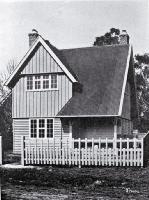Department of Labour Court
- The Department of Labour’s court was specifically designed to showcase New Zealand as the "social laboratory of the world".
- The displays and exhibits highlighted New Zealand’s labour laws and the positive effect these had on conditions for the country’s workers.
Introduction
Minister of Labour, Richard John Seddon issued instructions early in 1906 that the court should demonstrate the Department’s work by way of statistical charts, photographs, publications and models. These displays focused on Liberal Government legislation that was designed to avoid the social evils of the Old World and to create a workingman’s paradise in the "Britain of the South". The departmental court was developed by J.W. Collins under the supervision of the Secretary of Labour, Edward Robert Tregear, with W. H. Hagger as the on-site manager.
The material displayed featured New Zealand’s labour laws, especially on wages and hours of work, factory and trade union legislation, arbitration court decisions, workers’ compensation, and workers’ accommodation legislation. There were also charts demonstrating the Department’s successful battle to reduce unemployment over the previous ten years. Other exhibits at the Labour court focused on specific industries and included items relating to the production of kauri gum, printing and timber. The Department of Labour court exhibit proved popular, attracting 160,000 visitors in the three months it was on display, so it was toured around the country after the Exhibition ended.
Workers’ Accommodation
The Department of Labour had been responsible for enacting several schemes that provided accommodation for working people and examples of this were also on display. A model shearing shed demonstrated the improved accommodation afforded shearers under the Shearers’ Accommodation Act (1898), while photographs showed the houses available to co-operative workers carrying out road and railway construction. There were models, photographs, plans and sketches illustrating houses being erected under the Workers’ Dwellings Act (1906), and outside the Main Building, near Victoria Lake was a full-size worker’s cottage, designed by architects Wood, Hurst and Seagar. At first, this building was open for inspection on Tuesdays, Thursdays and Saturdays from 2-5pm but from 5 December, the Department arranged for it to be open daily. It was later re-erected at 52 Longfellow Street in Addington.
Working conditions
The message promoted by the Department of Labour’s court, of the good work they had done in improving the lot of workers, was further reinforced by another exhibit, "English Sweated Industries". This exhibit, which was put together from materials collected by former Minister of Labour and now High Commissioner in London, William Pember Reeves displayed goods made under "sweated" conditions in England. These included items such as match boxes, buttons, clothing, boots and shoes, hats, racquet balls, paper bags, sacks, nails, and artificial flowers etc. Accompanying these were notes on the rates paid, working hours, and earnings of the workers who endured "wage slavery" to produce them.
This exhibit showed "for what miserable reward people in Great Britain are forced to manufacture articles … They are exhibited here as a warning against that which will happen if strenuous and sustained efforts are not made to bar the entrance of the system through which such results become possible".1 This "awful story of human toil and human suffering"2 it could be concluded, was kept out of the colony by Liberal legislation and union awards which controlled the wages and working conditions of workers, especially women and children.
![]()
Sources
- Cowan, J. Official record of the New Zealand International Exhibition of Arts and Industries held at Christchurch, 1906-7, page 148-152
- English "Sweated Industries" exhibit catalogue, N.Z. International Exhibition, Christchurch, page 1
- Martin, J. "The ‘social laboratory’ writ large?: The Dept of Labour’s Court", In J.M. Thomson (Ed.), Farewell colonialism : the New Zealand International Exhibition, Christchurch, 1906-07, page 129-140.
- A print series commemorating the Department of Labour’s 100th year.
Related links
- Richard John Seddon in the Dictionary of New Zealand Biography.
- William Pember Reeves in the Dictionary of New Zealand Biography.
- Edward Robert Tregear in the Dictionary of New Zealand Biography.
- Department of Labour in An Encyclopaedia of New Zealand.





